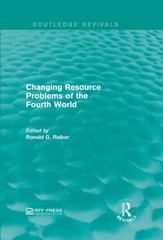Question
2. The NPV and the discount rate . Assume a stylized environmental investment project which consists of investing a large amount today, denoted by Celcum
2. The NPV and the discount rate. Assume a stylized environmental investment project which consists of investing a large amount today, denoted by Celcum (e.g. immediate and radical measures to shift away from fossil fuels) in exchange of receiving benefits of A per year (A for "annuity"), forever in the future (e.g. thanks to climate stabilization for all future generations). Assume Celcium =50A. Without discounting, as the sum of benefits is infinite, it may appear like a good deal for society, with an infinite net benefit! But we know that what applies over time is the NPV criterion, not the BC criterion. So we have to consider the discount rate.Let us do that in two steps, assuming Celcum is equal to USD 36 trillion (we consider the world, and the world is big).
(i) Prove the following formula, useful to calculate the PV of a perpetual flow of A in the future.
Hint: remember that if Sn = a+ a^2 + ... a^n ==> Sn =(a-a^n+1)/(1-a) this formula is also used to calculate the price of a perpetual bon or "consol" introduced in GB around 175P:
?? ?A/(1+r)? + ?A/(1+r)2? + ?A/(1+r)n? = ?A?(1?(1+r)?n)/r? ==(n ==>infinity) ?A?(1/r)?
(ii) Use the above formula to calculate the NPV of the project for three alternative discount rates: 1%, 2% and 3%. Comment.
Please help me to solve this problem
 2. The NPV and the discount rate. Assume a stylized environmental investment project which consists of investing a large amount today, denoted by Co (e.g. immediate and radical measures to shift away from fossil fuels) in exchange of receiving benefits of A per year (A for "annuity"), forever in the future (e.g. thanks to climate stabilization for all future generations). Assume Co=50A. Without discounting, as the sum of benefits is infinite, it may appear like a good deal for society, with an infinite net benefit! But we know that what applies over time is the NPV criterion, not the BC criterion. So we have to consider the discount rate. Let us do that in two steps, assuming Co is equal to USD 36 trillion (we consider the world, and the world is big). (i) Prove the following formula, useful to calculate the PV of a perpetual flow of A in the future. Hint: remember that if S,, =ata +...+a" => S, =(a-a"*)/(1-a) (this formula is also used to calculate the price of a perpetual bond or "consol" introduced in GB around 1750): A A 1-(1+r)" + ... (1 +r) (1+r)= (1+r)" r (ii) Use the above formula to calculate the NPV of the project for three alternative discount rates: 1%, 2% and 3%. Comment
2. The NPV and the discount rate. Assume a stylized environmental investment project which consists of investing a large amount today, denoted by Co (e.g. immediate and radical measures to shift away from fossil fuels) in exchange of receiving benefits of A per year (A for "annuity"), forever in the future (e.g. thanks to climate stabilization for all future generations). Assume Co=50A. Without discounting, as the sum of benefits is infinite, it may appear like a good deal for society, with an infinite net benefit! But we know that what applies over time is the NPV criterion, not the BC criterion. So we have to consider the discount rate. Let us do that in two steps, assuming Co is equal to USD 36 trillion (we consider the world, and the world is big). (i) Prove the following formula, useful to calculate the PV of a perpetual flow of A in the future. Hint: remember that if S,, =ata +...+a" => S, =(a-a"*)/(1-a) (this formula is also used to calculate the price of a perpetual bond or "consol" introduced in GB around 1750): A A 1-(1+r)" + ... (1 +r) (1+r)= (1+r)" r (ii) Use the above formula to calculate the NPV of the project for three alternative discount rates: 1%, 2% and 3%. Comment Step by Step Solution
There are 3 Steps involved in it
Step: 1

Get Instant Access to Expert-Tailored Solutions
See step-by-step solutions with expert insights and AI powered tools for academic success
Step: 2

Step: 3

Ace Your Homework with AI
Get the answers you need in no time with our AI-driven, step-by-step assistance
Get Started


